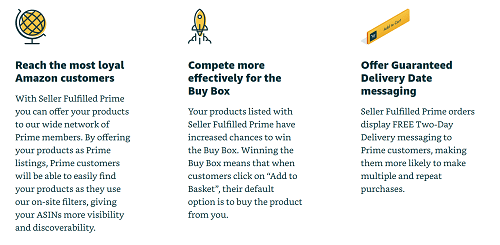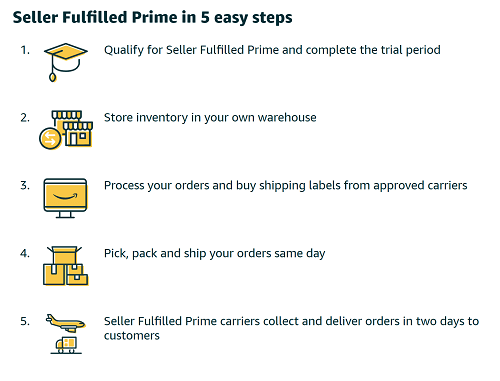If you’re not yet selling on Amazon Prime, you’re missing out on some big benefits. On Prime, you get access to a devoted customer base – some who will only buy Prime products on Amazon. And it’s not an insignificant number: in 2019, 51.3% of U.S. households are Prime members, according to eMarketer’s forecast. That’s 5.2 million more Amazon Prime members compared to 2018. Many of those households have multiple “buyers” thanks to Amazon Household, which allows members to connect and share Prime benefits with their families.

Screenshot via Amazon
Why You Should Be Selling on Amazon Prime
Overall, there are more than 100 million Amazon Prime members. Those millions of Amazon Prime customers (about 61% of total Amazon customers) spend an average of $1,400 per year on Amazon, more than double the $600 per year, on average, non-Prime members spend. They also shop more often: 26 times per year, compared to 14 shopping trips for non-Prime customers, spend more per trip: $55 per visit, compared to $42 per visit for non-Prime customers, and buy more items per visit: 2.2 items per visit, compared to 2 items per visit for non-Prime customers.
In other words, if you’re not selling on Prime, you could be missing opportunities to sell to more than 6 out of 10 Amazon customers – customers who tend to spend more than twice as much each year than their non-Prime member counterparts.
Now that you’re sufficiently convinced that you need to be selling on Amazon Prime, here’s how to get started.
How to Sell on Amazon Prime
Not all sellers qualify to sell on Amazon Prime. To be eligible, you must be an Amazon FBA seller or qualify for the Seller Fulfilled Prime (SFP) program. Amazon FBA sellers’ products are eligible for Amazon Prime, while sellers opting for SFP must apply and get certified. Learn more about how to list FBA products here.
The main difference between the two is that Seller Fulfilled Prime sellers ship inventory from their own warehouses using approved carriers while meeting the Prime two-day delivery promise and other minimum requirements. Seller Fulfilled Prime sellers also pay for their own shipping costs, although they aren’t subject to fees specific to Amazon FBA. (Use a good Amazon FBA calculator to determine your fees.)
Amazon Prime sellers using Amazon FBA and SFP must also have good seller performance metrics. After all, Amazon’s Prime service is one of its star programs, and sellers that don’t hold up their end of the deal reflect poorly on Prime. That said, because SFP sellers are handling their own inventory storage and shipping, they need to prove that they can uphold Amazon’s Prime guarantees.

Screenshot via Amazon
While the requirements are strict, the benefits are well worth it. Amazon Prime sellers have better chances of winning the Buy Box, and the Free Two-Day Delivery messaging on product detail pages is a motivator for shoppers to make purchases. And, of course, you’ll get access to those loyal Amazon Prime customers we talked about earlier.
How to Get Certified for Seller Fulfilled Prime
Currently, Amazon isn’t accepting new registrations for Seller Fulfilled Prime, although you can sign up for the wait list. Seller Fulfilled Prime is ideal for:
- High-value items
- Seasonal items
- Items with unpredictable demand
- Slow-moving items
- Items with several variations
- Items requiring special preparation or handling

Screenshot via Amazon
Sellers who sell via the Seller Fulfilled Prime program can display the Prime badge (after the initial trial period) and deliver products to domestic Prime customers from their own warehouse, but they must commit to the Prime promise of two-day delivery at no additional charge to customers.
To qualify for Seller Fulfilled Prime, sellers must:
- Have a Professional Seller account in good standing
- Offer Premium Shipping options
- Ship a minimum of orders on time (picking, packing and shipping orders the same day)
- Maintain an order cancellation rate of less than 0.5%
- Use Amazon Buy Shipping Services for a minimum of 98.5% of orders
- Agree to the Amazon Returns Policy
- Use supported Seller Fulfilled Prime carriers to deliver orders
- Allow Amazon to handle all customer service inquiries
Sellers interested in Seller Fulfilled Prime first must complete a trial period to prove that they can meet these minimum thresholds and maintain Prime fulfillment excellence and customer satisfaction. After being approved for a Seller Fulfilled Prime trial, sellers assign SKUs to the Prime Shipping Template – failing to add SKUs means any orders for those items won’t be counted towards your performance results. During the trial period, which lasts between 5 and 90 days, sellers must fulfill 200 Prime Trial orders, while meeting all requirements:
- 99% or higher on-time shipping rate (zero-day handling time, shipped same-day or before the cutoff time)
- 95% or higher rate of using Buy Shipping Services
- Less than 1% order cancellations
If a seller doesn’t meet these requirements during the initial 90 days, they can try again with a reset trial period. After passing the trial period, sellers can display the Prime badge on eligible products enrolled in SFP.
Offering Amazon Prime shipping has become a must for Amazon sellers, offering advantages such as a better competitive edge for winning the Buy Box and access to dedicated Prime shoppers. While selling with Amazon FBA is the easiest way to get started with Prime, Seller Fulfilled Prime is an option for non-FBA sellers who want to take advantage of the Prime perks. While qualifying for Seller Fulfilled Prime may seem intimidating, the benefits are well worth it, particularly for sellers who prefer to handle their own inventory or want to avoid Amazon FBA fees.





